Problem-Solving Method in Teaching
The problem-solving method is a highly effective teaching strategy that is designed to help students develop critical thinking skills and problem-solving abilities . It involves providing students with real-world problems and challenges that require them to apply their knowledge, skills, and creativity to find solutions. This method encourages active learning, promotes collaboration, and allows students to take ownership of their learning.

Table of Contents
Definition of problem-solving method.
Problem-solving is a process of identifying, analyzing, and resolving problems. The problem-solving method in teaching involves providing students with real-world problems that they must solve through collaboration and critical thinking. This method encourages students to apply their knowledge and creativity to develop solutions that are effective and practical.
Meaning of Problem-Solving Method
The meaning and Definition of problem-solving are given by different Scholars. These are-
Woodworth and Marquis(1948) : Problem-solving behavior occurs in novel or difficult situations in which a solution is not obtainable by the habitual methods of applying concepts and principles derived from past experience in very similar situations.
Skinner (1968): Problem-solving is a process of overcoming difficulties that appear to interfere with the attainment of a goal. It is the procedure of making adjustments in spite of interference
Benefits of Problem-Solving Method
The problem-solving method has several benefits for both students and teachers. These benefits include:
- Encourages active learning: The problem-solving method encourages students to actively participate in their own learning by engaging them in real-world problems that require critical thinking and collaboration
- Promotes collaboration: Problem-solving requires students to work together to find solutions. This promotes teamwork, communication, and cooperation.
- Builds critical thinking skills: The problem-solving method helps students develop critical thinking skills by providing them with opportunities to analyze and evaluate problems
- Increases motivation: When students are engaged in solving real-world problems, they are more motivated to learn and apply their knowledge.
- Enhances creativity: The problem-solving method encourages students to be creative in finding solutions to problems.
Steps in Problem-Solving Method
The problem-solving method involves several steps that teachers can use to guide their students. These steps include
- Identifying the problem: The first step in problem-solving is identifying the problem that needs to be solved. Teachers can present students with a real-world problem or challenge that requires critical thinking and collaboration.
- Analyzing the problem: Once the problem is identified, students should analyze it to determine its scope and underlying causes.
- Generating solutions: After analyzing the problem, students should generate possible solutions. This step requires creativity and critical thinking.
- Evaluating solutions: The next step is to evaluate each solution based on its effectiveness and practicality
- Selecting the best solution: The final step is to select the best solution and implement it.
Verification of the concluded solution or Hypothesis
The solution arrived at or the conclusion drawn must be further verified by utilizing it in solving various other likewise problems. In case, the derived solution helps in solving these problems, then and only then if one is free to agree with his finding regarding the solution. The verified solution may then become a useful product of his problem-solving behavior that can be utilized in solving further problems. The above steps can be utilized in solving various problems thereby fostering creative thinking ability in an individual.
The problem-solving method is an effective teaching strategy that promotes critical thinking, creativity, and collaboration. It provides students with real-world problems that require them to apply their knowledge and skills to find solutions. By using the problem-solving method, teachers can help their students develop the skills they need to succeed in school and in life.
- Jonassen, D. (2011). Learning to solve problems: A handbook for designing problem-solving learning environments. Routledge.
- Hmelo-Silver, C. E. (2004). Problem-based learning: What and how do students learn? Educational Psychology Review, 16(3), 235-266.
- Mergendoller, J. R., Maxwell, N. L., & Bellisimo, Y. (2006). The effectiveness of problem-based instruction: A comparative study of instructional methods and student characteristics. Interdisciplinary Journal of Problem-based Learning, 1(2), 49-69.
- Richey, R. C., Klein, J. D., & Tracey, M. W. (2011). The instructional design knowledge base: Theory, research, and practice. Routledge.
- Savery, J. R., & Duffy, T. M. (2001). Problem-based learning: An instructional model and its constructivist framework. CRLT Technical Report No. 16-01, University of Michigan. Wojcikowski, J. (2013). Solving real-world problems through problem-based learning. College Teaching, 61(4), 153-156
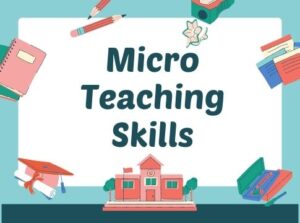
- Illinois Online
- Illinois Remote
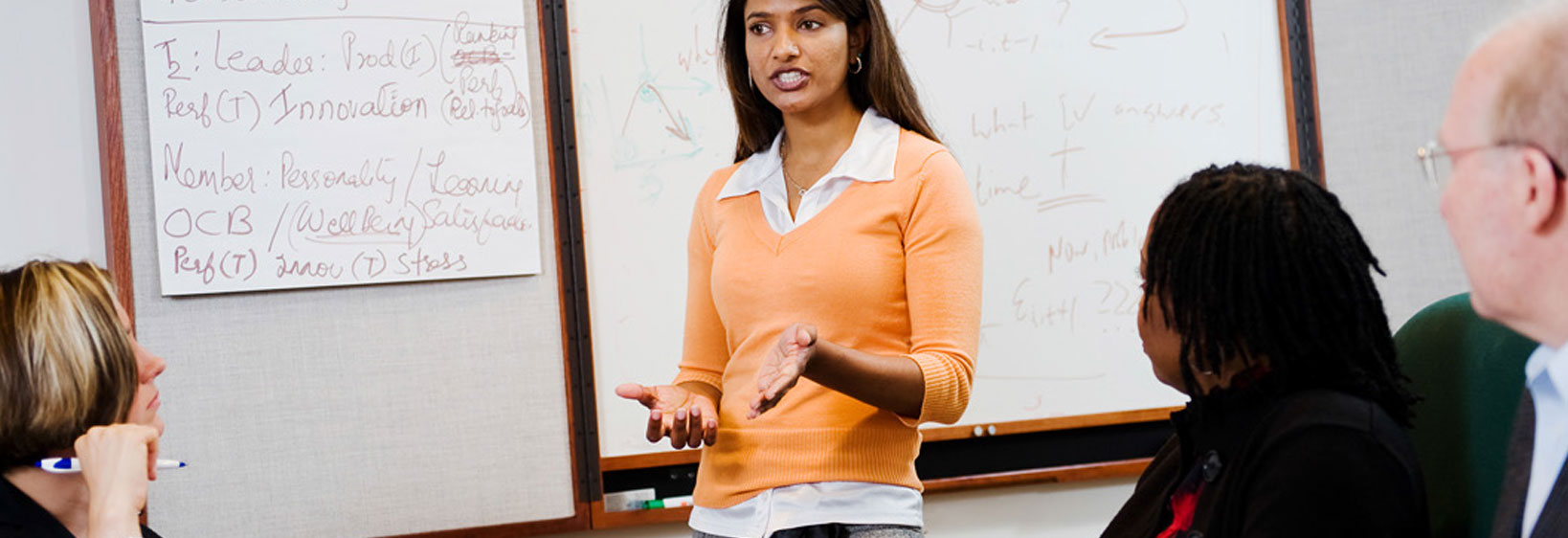
- TA Resources
- Teaching Consultation
- Teaching Portfolio Program
- Grad Academy for College Teaching
- Faculty Events
- The Art of Teaching
- 2022 Illinois Summer Teaching Institute
- Large Classes
- Leading Discussions
- Laboratory Classes
- Lecture-Based Classes
- Planning a Class Session
- Questioning Strategies
- Classroom Assessment Techniques (CATs)
- Problem-Based Learning (PBL)
- The Case Method
- Community-Based Learning: Service Learning
- Group Learning
- Just-in-Time Teaching
- Creating a Syllabus
- Motivating Students
- Dealing With Cheating
- Discouraging & Detecting Plagiarism
- Diversity & Creating an Inclusive Classroom
- Harassment & Discrimination
- Professional Conduct
- Foundations of Good Teaching
- Student Engagement
- Assessment Strategies
- Course Design
- Student Resources
- Teaching Tips
- Graduate Teacher Certificate
- Certificate in Foundations of Teaching
- Teacher Scholar Certificate
- Certificate in Technology-Enhanced Teaching
- Master Course in Online Teaching (MCOT)
- 2022 Celebration of College Teaching
- 2023 Celebration of College Teaching
- Hybrid Teaching and Learning Certificate
- Classroom Observation Etiquette
- Teaching Philosophy Statement
- Pedagogical Literature Review
- Scholarship of Teaching and Learning
- Instructor Stories
- Podcast: Teach Talk Listen Learn
- Universal Design for Learning
Sign-Up to receive Teaching and Learning news and events
Problem-Based Learning (PBL) is a teaching method in which complex real-world problems are used as the vehicle to promote student learning of concepts and principles as opposed to direct presentation of facts and concepts. In addition to course content, PBL can promote the development of critical thinking skills, problem-solving abilities, and communication skills. It can also provide opportunities for working in groups, finding and evaluating research materials, and life-long learning (Duch et al, 2001).
PBL can be incorporated into any learning situation. In the strictest definition of PBL, the approach is used over the entire semester as the primary method of teaching. However, broader definitions and uses range from including PBL in lab and design classes, to using it simply to start a single discussion. PBL can also be used to create assessment items. The main thread connecting these various uses is the real-world problem.
Any subject area can be adapted to PBL with a little creativity. While the core problems will vary among disciplines, there are some characteristics of good PBL problems that transcend fields (Duch, Groh, and Allen, 2001):
- The problem must motivate students to seek out a deeper understanding of concepts.
- The problem should require students to make reasoned decisions and to defend them.
- The problem should incorporate the content objectives in such a way as to connect it to previous courses/knowledge.
- If used for a group project, the problem needs a level of complexity to ensure that the students must work together to solve it.
- If used for a multistage project, the initial steps of the problem should be open-ended and engaging to draw students into the problem.
The problems can come from a variety of sources: newspapers, magazines, journals, books, textbooks, and television/ movies. Some are in such form that they can be used with little editing; however, others need to be rewritten to be of use. The following guidelines from The Power of Problem-Based Learning (Duch et al, 2001) are written for creating PBL problems for a class centered around the method; however, the general ideas can be applied in simpler uses of PBL:
- Choose a central idea, concept, or principle that is always taught in a given course, and then think of a typical end-of-chapter problem, assignment, or homework that is usually assigned to students to help them learn that concept. List the learning objectives that students should meet when they work through the problem.
- Think of a real-world context for the concept under consideration. Develop a storytelling aspect to an end-of-chapter problem, or research an actual case that can be adapted, adding some motivation for students to solve the problem. More complex problems will challenge students to go beyond simple plug-and-chug to solve it. Look at magazines, newspapers, and articles for ideas on the story line. Some PBL practitioners talk to professionals in the field, searching for ideas of realistic applications of the concept being taught.
- What will the first page (or stage) look like? What open-ended questions can be asked? What learning issues will be identified?
- How will the problem be structured?
- How long will the problem be? How many class periods will it take to complete?
- Will students be given information in subsequent pages (or stages) as they work through the problem?
- What resources will the students need?
- What end product will the students produce at the completion of the problem?
- Write a teacher's guide detailing the instructional plans on using the problem in the course. If the course is a medium- to large-size class, a combination of mini-lectures, whole-class discussions, and small group work with regular reporting may be necessary. The teacher's guide can indicate plans or options for cycling through the pages of the problem interspersing the various modes of learning.
- The final step is to identify key resources for students. Students need to learn to identify and utilize learning resources on their own, but it can be helpful if the instructor indicates a few good sources to get them started. Many students will want to limit their research to the Internet, so it will be important to guide them toward the library as well.
The method for distributing a PBL problem falls under three closely related teaching techniques: case studies, role-plays, and simulations. Case studies are presented to students in written form. Role-plays have students improvise scenes based on character descriptions given. Today, simulations often involve computer-based programs. Regardless of which technique is used, the heart of the method remains the same: the real-world problem.
Where can I learn more?
- PBL through the Institute for Transforming Undergraduate Education at the University of Delaware
- Duch, B. J., Groh, S. E, & Allen, D. E. (Eds.). (2001). The power of problem-based learning . Sterling, VA: Stylus.
- Grasha, A. F. (1996). Teaching with style: A practical guide to enhancing learning by understanding teaching and learning styles. Pittsburgh: Alliance Publishers.
Center for Innovation in Teaching & Learning
249 Armory Building 505 East Armory Avenue Champaign, IL 61820
217 333-1462
Email: [email protected]
Office of the Provost
Center for Teaching
Teaching problem solving.
Print Version
Tips and Techniques
Expert vs. novice problem solvers, communicate.
- Have students identify specific problems, difficulties, or confusions . Don’t waste time working through problems that students already understand.
- If students are unable to articulate their concerns, determine where they are having trouble by asking them to identify the specific concepts or principles associated with the problem.
- In a one-on-one tutoring session, ask the student to work his/her problem out loud . This slows down the thinking process, making it more accurate and allowing you to access understanding.
- When working with larger groups you can ask students to provide a written “two-column solution.” Have students write up their solution to a problem by putting all their calculations in one column and all of their reasoning (in complete sentences) in the other column. This helps them to think critically about their own problem solving and helps you to more easily identify where they may be having problems. Two-Column Solution (Math) Two-Column Solution (Physics)
Encourage Independence
- Model the problem solving process rather than just giving students the answer. As you work through the problem, consider how a novice might struggle with the concepts and make your thinking clear
- Have students work through problems on their own. Ask directing questions or give helpful suggestions, but provide only minimal assistance and only when needed to overcome obstacles.
- Don’t fear group work ! Students can frequently help each other, and talking about a problem helps them think more critically about the steps needed to solve the problem. Additionally, group work helps students realize that problems often have multiple solution strategies, some that might be more effective than others
Be sensitive
- Frequently, when working problems, students are unsure of themselves. This lack of confidence may hamper their learning. It is important to recognize this when students come to us for help, and to give each student some feeling of mastery. Do this by providing positive reinforcement to let students know when they have mastered a new concept or skill.
Encourage Thoroughness and Patience
- Try to communicate that the process is more important than the answer so that the student learns that it is OK to not have an instant solution. This is learned through your acceptance of his/her pace of doing things, through your refusal to let anxiety pressure you into giving the right answer, and through your example of problem solving through a step-by step process.
Experts (teachers) in a particular field are often so fluent in solving problems from that field that they can find it difficult to articulate the problem solving principles and strategies they use to novices (students) in their field because these principles and strategies are second nature to the expert. To teach students problem solving skills, a teacher should be aware of principles and strategies of good problem solving in his or her discipline .
The mathematician George Polya captured the problem solving principles and strategies he used in his discipline in the book How to Solve It: A New Aspect of Mathematical Method (Princeton University Press, 1957). The book includes a summary of Polya’s problem solving heuristic as well as advice on the teaching of problem solving.

Teaching Guides
- Online Course Development Resources
- Principles & Frameworks
- Pedagogies & Strategies
- Reflecting & Assessing
- Challenges & Opportunities
- Populations & Contexts
Quick Links
- Services for Departments and Schools
- Examples of Online Instructional Modules

- My presentations
Auth with social network:
Download presentation
We think you have liked this presentation. If you wish to download it, please recommend it to your friends in any social system. Share buttons are a little bit lower. Thank you!
Presentation is loading. Please wait.
Problem Solving Strategies
Published by Tyler Perkins Modified over 8 years ago
Similar presentations
Presentation on theme: "Problem Solving Strategies"— Presentation transcript:
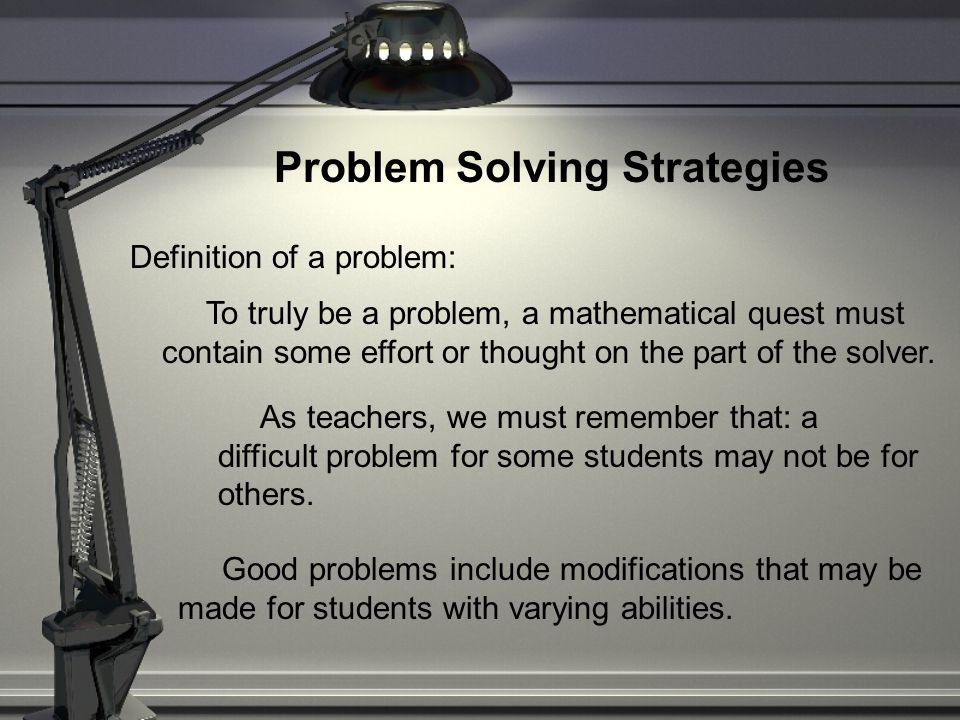
An introduction to Problem Solving Math 110 Iris Yang.

M ATHEMATICAL P ROBLEM S OLVING What is it? Why encourage it? How is teaching like a problem-solving endeavor?

Chapter 1 The Art of Problem Solving © 2008 Pearson Addison-Wesley. All rights reserved.

Kevin Cummins The maths toolbox is a set of strategies that students can put into place to solve mathematical problems. The purpose.

Polya’s Four Step Problem Solving Process

Welcome to MATH 302A Please find the index card with your name on it and sit there. On the other side of the index card, write: Name as you wish to be.

MAKING PROBLEM SOLVING LESS PROBLEMATIC

Exploration 1.1 With 24 people in class, including yourself, if each person shakes hands with every person, how many handshakes will there be?

Problem Solving The process of applying previously acquired knowledge to new and unfamiliar situations.

Correlating Go Math & Standards for Mathematical Practices

SASE Contextualised group work – teaching a broader mathematics curriculum to first year science students: Case study – Problem solving Jo-ann Larkins.

Problem Solving Tool: KFC.

Test Preparation Strategies

Survey of Mathematical Ideas Math 100 Chapter 1 John Rosson Tuesday January 23, 2007.

M ATH C OMMITTEE Mathematical Shifts Mathematical Practices.

PROBLEM SOLVING in Math What you need to know. OVERVIEW: Define “Problem” Where do I start… How can I solve problems… Trying strategies –Patterns –Tables.

Problem solving Math 123. Why problem solving? Essential for mathematics According to NCTM, one of the processes through which mathematics should be.

Helping Children with Problem Solving CHAPTER 6 Tina Rye Sloan To accompany Helping Children Learn Math9e, Reys et al. ©2009 John Wiley & Sons.

Helping Children with Problem Solving CHAPTER 6 Tina Rye Sloan To accompany Helping Children Learn Math10e, Reys et al. ©2012John Wiley & Sons.

Buckland CE Primary School
About project
© 2024 SlidePlayer.com Inc. All rights reserved.


Teaching Problem Solving
Jul 17, 2014
350 likes | 668 Views
Teaching Problem Solving. Marie Norman, PhD. Associate Director and Coordinator of Graduate Student Programs Eberly Center for Teaching Excellence [email protected]. Mathematical problem solving: 4 steps. Posing the right question Translating a real-world problem into math Computation
Share Presentation
- mathy ted talks
- www youtube
- right question
- coordinator
- ask students

Presentation Transcript
Teaching Problem Solving Marie Norman, PhD Associate Director and Coordinator of Graduate Student Programs Eberly Center for Teaching Excellence [email protected]
Mathematical problem solving: 4 steps • Posing the right question • Translating a real-world problem into math • Computation • Translating math back into the real world • Conrad Wolfram, TED Talks: http://www.youtube.com/watch?v=60OVlfAUPJg
Mathematical problem solving: 4 steps • Posing the right question • Translating a real-world problem into math • Computation • Translating math back into the real world • 80% of math teaching focuses on this step.
Mathematical problem solving: 4 steps • Posing the right question • Translating a real-world problem into math • Computation • Translating math back into the real world • These steps tend to be neglected.
Dan Myer: Math class needs a makeover • TED talk, 2010 • http://www.youtube.com/watch?v=BlvKWEvKSi8 • What exactly is Myer advocating? • What ideas translate to your teaching context? • What other strategies can help?
“Patient problem solving” • Begin with a real-world problem. • Keep it messy (noise/missing info). • Emphasize reasoning over calculation. • Show how math creates efficiencies.
Begin with a real-world problem • You don’t need to solve the real-world problem in order to highlight the usefulness of the math it involves. • Ex. Tacoma Narrows Bridge collapse Think of some of the mathematical skills you teach. What are some real-world uses for these skills? How could you highlight them for students? Take a minute and jot down some ideas.
Keep it messy • Offer problems with irrelevant/missing information rather than nice, neat pieces, and ask questions like... • What information here is/isn’t relevant? • What additional information do you need?
Emphasize reasoning • Take time with problem formulation. • What are we trying to find out? • Encourage students to draw on their intuition. • What are some possible solution strategies? • Where have we seen this kind of problem before? • Does that answer feel right to you? Why not? • Focus on thought processes, not right answers. • Require students to explain answers, right or wrong.
Show how math creates efficiencies • Highlight when problem solving would be inefficient and laborious without mathematical modeling. • “We could watch the tank fill for 6 hours to get the answer, or we could solve it mathematically...” • “We could add up every one of these columns and rows by hand,or we could just...”
2 useful things to keep in mind...
#1. Expert blind spot Imagine you are a novice cook... How helpful is it if an experienced chef gives you instructions like: “add spices until it tastes right” and “cook until the sauce looks done”?
The development of expertise
Expert blind spot = ENEMY #1! Experts often… • Over-estimate what novices know and can do • Under-estimate how long novices will take • Don’t see the steps/pieces novices must learn • Mis-predict where novices will have difficulty • Presume that novices do things the way they do Hinds (1999); Nathan & Koedinger (2000); Nickerson (1999)
#2: Types of knowledge Knowing what: facts, definitions, formulae Knowing why: concepts, relationships Knowing how: procedures, methods, steps Knowing when: conditions of applicability Not the same!
Juggling theorem: b/h = (d+f)/(d+e)
#2: Types of knowledge Knowing what: facts, definitions, formulae Knowing why: concepts, relationships Knowing how: procedures, methods, steps Knowing when: conditions of applicability Which do you think get the most emphasis in math ed?
If we don’t teach all four types... Students may be able to... • apply a formula, but not explain the concept from which it is derived (how but not why). • state a theorem but not know when or where to apply it (what but not when). • explain a procedure but not perform it (why but not how) Sound familiar?
What are some things you can do to guard against expert blind spot?
Break down skills and steps • Identify all the components of a complex skill. • Teach them systematically and slowly. • Spell out (and number, if appropriate) steps. • See Khan Academy videos for excellent examples of step by step teaching: http://www.khanacademy.org/
Give students targeted practice • Sometimes the best way to teach problem solving isn’t to solve whole problems. • Instead (or in addition), consider doing the following...
Assign “worked problems” • Give students step-by-step solutions to study before they attempt similar problems. • Sweller& Cooper, 1987: students who studied worked examples perform significantly better than students who just solved problems. • Most effective with novice students, where text and diagrams are effectively integrated (or animated.)
Assign partially worked problems • Give students worked problems with blanks for missing steps and have them complete just those steps. • Focus on steps they struggle with or often omit.
Have students plan solution strategies • Have students plan solution strategies for multiple problems withoutimplementing them. • This gives them targeted practice with planning, a step they generally neglect (experts generally spend far more time planning a solution and less time executing it, while novices do the reverse.)
Have students find errors • Give students solutions that they know contain errors and ask them to identify and fix the errors • This requires a deep understanding of the problem and all its steps.
What can you do to reinforce key types of knowledge (e.g., why/when/how)?
Require students to explain • Never accept an answer without an explanation. Instead, ask: How did you get that? • This reinforces “conceptual knowledge” (knowing why).
Reinforce skill of selection • Ask students to sort problems by solution type. • Have students generate a range of solution strategies and compare/evaluate them. • Discuss “conditions of applicability”: • Would you use ANOVA here? Why or why not? • Would you use algebra or calculus to solve this? • This reinforces “conditional knowledge” (knowing when).
Teach heuristics • Identify short-cuts and rules of thumb that you (an expert) use, e.g. “When I see a complicated problem, I try to think of a simpler, analogous problem...” • This reinforces “procedural knowledge” (knowing how). What heuristics do you use that would be useful for your students to know? Jot one or two down.
Heuristics (examples) • Sketch it out • Look for patterns • Work backwards • Make a guess and check • Restate the problem in another way • Simplify the problem (e.g., use whole numbers) • ??
Summary • Link math to the real world. • Focus on reasoning. • Watch out for expert blind spot • Reinforce all four types of knowledge
Mathy TED Talks • Geoffrey West: The Surprising Math of Cities and Corporations • Margaret Wertheim: The Beautiful Math of Coral • Kevin Slavin: How Algorithms Shape Our World • Dan Myer: Math Class Needs a Makeover • Conrad Wolfram: Teaching Kids Real Math with Computers • Arthur Benjamin’s formula for changing math education • Benoit Mandelbrot: Fractals and the Art of Roughness • Scott Rickard: The beautiful math behind the ugliest music • Marcus Du Sautoy: Symmetry, reality’s riddle • Ron Eglash on African fractals • For these and others, see http://www.ted.com/talks
- More by User

Problem Solving
Problem Solving Views of Problem solving Well-defined problems Much studied in AI Requires search Domain general heuristics for solving problems What about ill-defined problems? No real mechanisms for dealing with these
1.26k views • 33 slides
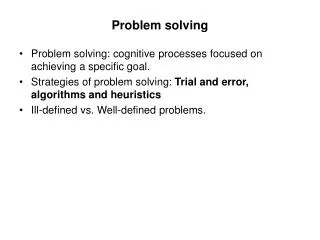
Problem solving
Problem solving. Problem solving: cognitive processes focused on achieving a specific goal. Strategies of problem solving: Trial and error, algorithms and heuristics Ill-defined vs. Well-defined problems. Heuristics vs. algorithms.
955 views • 22 slides

Problem Solving. From Conceptual Blockbusting , 4 th Edition, by James L. Adams. Solve This Puzzle.
920 views • 17 slides
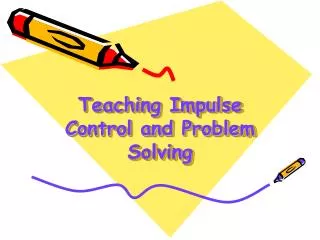
Teaching Impulse Control and Problem Solving
Teaching Impulse Control and Problem Solving. Anger Management and Impulse Control. Recognizing that anger can interfere with problem solving Learning how to recognize anger in oneself and others Learning how to calm down Understanding appropriate ways to express anger.
409 views • 25 slides

Teaching (and Learning) Through Problem Solving
Teaching (and Learning) Through Problem Solving. Perspectives. TTPS: Teaching ABOUT Problem Solving. For the last 25-30 years, “ Problem Solving ” has become an increasing focus of mathematics education, including elementary level mathematics.
146 views • 11 slides

Module 10: Teaching Problem Solving Skills
Effective Teacher Practices Supporting the North Carolina Foundations for Early Learning and Development 2018. Module 10: Teaching Problem Solving Skills. Review of Pre-learning Assignment. Respond to the questions below: Do you have any AHA thoughts after reading the article?
566 views • 41 slides

Teaching Mathematics through Problem Solving
Teaching Mathematics through Problem Solving. Sonja Karsh and Joyce Tonner Student Achievement Officers, Literacy and Numeracy Secretariat. Teaching Through Problem Solving.
545 views • 27 slides
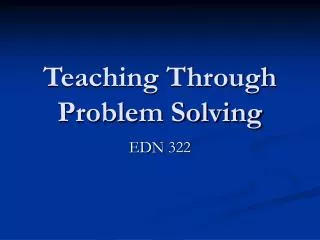
Teaching Through Problem Solving
Teaching Through Problem Solving. EDN 322. NCTM process standards. Problem solving Reasoning and proof Communication Connections Representation. What is a problem? (Van De Walle, 2004). A problem is any task or exploration for which the solution has not been explained…
235 views • 9 slides
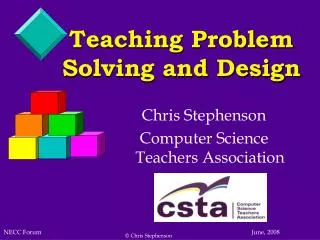
Teaching Problem Solving and Design
Teaching Problem Solving and Design. Chris Stephenson Computer Science Teachers Association. The Goal. A primary goal of curriculum reform is to create classrooms in which students: are challenged to think critically learn how to discover, understand, and analyze
347 views • 13 slides
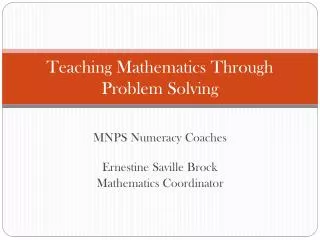
Teaching Mathematics Through Problem Solving
Teaching Mathematics Through Problem Solving. MNPS Numeracy Coaches Ernestine Saville Brock Mathematics Coordinator. MNPS Vision.
771 views • 53 slides

Problem Solving. Steps and Vocabulary Martha Rice. Problems are all around!. You can use the same problem solving methods to solve just about any problem, from word problems to logic problems to real-world problems in your own life. Step 1: Evaluate the evidence.
602 views • 17 slides

Problem Solving. Problem Solving Approach. Break it down into smaller, manageable pieces Procedural approach: Break it down into a sequence of steps Consider tasks to be accomplished. Problem Solving Approach. Break it down into smaller, manageable pieces Procedural approach:
285 views • 7 slides

Problem solving. Original Source : http://www.ftsm.ukm.my/zma/TK1914/05-Algorithms and Problem Solving.ppt. Problem Solving. Programming is a process of problem solving Problem solving techniques Analyze the problem Outline the problem requirements
1.22k views • 20 slides
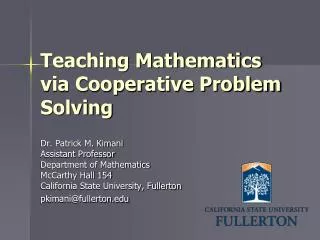
Teaching Mathematics via Cooperative Problem Solving
Teaching Mathematics via Cooperative Problem Solving. Dr. Patrick M. Kimani Assistant Professor Department of Mathematics McCarthy Hall 154 California State University, Fullerton [email protected]. Overview. Background Standards Activity! Discussion Reflection. Background.
410 views • 19 slides

Problem Solving. Lecture 2. INTRODUCTION TO PROBLEM SOLVING.
303 views • 24 slides
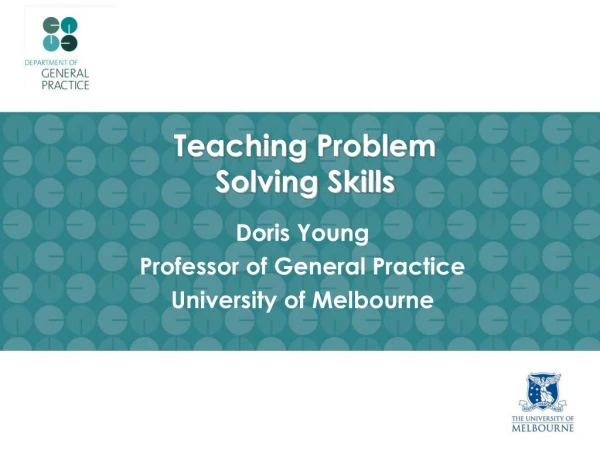
Teaching Problem Solving Skills
Teaching Problem Solving Skills. Doris Young Professor of General Practice University of Melbourne. What are the ingredients of a 5 star doctor?. Astute Diagnostician Up to date knowledge Good communicator Preventive health Appropriate use of health resources. Diagnostician.
232 views • 16 slides
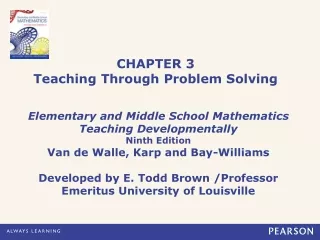
CHAPTER 3 Teaching Through Problem Solving
CHAPTER 3 Teaching Through Problem Solving. Elementary and Middle School Mathematics Teaching Developmentally Ninth Edition Van de Walle, Karp and Bay-Williams Developed by E. Todd Brown /Professor Emeritus University of Louisville. Problem Solving. Teaching for problem solving
218 views • 17 slides

TIPS Teaching Interpersonal Problem Solving
TIPS Teaching Interpersonal Problem Solving. CEP 866 Allison Lackie Priscilla Riojas Brooke Seyffert Megan Wilson. Context of the Problem. Relevant Statistic
210 views • 20 slides

Problem Solving and Programming – Problem Solving
Dr Scott Turner. Problem Solving and Programming – Problem Solving. Why do you needed to develop problem solving skills?. One definition of programming is it is applied problem solving You have a problem (E.g Need a program to calculate the area of the circle). What needs to be done?
683 views • 29 slides

Problem Solving. We now have enough tools to start solving some problems. For any problem, BEFORE you start writing a program, determine: What are the input values that are needed from the user? What results (outputs) do we need to determine? What other values are needed?
560 views • 39 slides

Problem Solving. Intro to Computer Science CS1510 Dr. Sarah Diesburg. Numeric representation. We usually work with decimal numbers with digits from 0 to 9 and powers of 10 7313 = (7 * 1000 + 3 * 100 + 1 * 10 + 3 * 1) Or (7 * 10 3 + 3 * 10 2 + 1 * 10 1 + 3 * 10 0 )
352 views • 12 slides
- Preferences

Problem Solving Method In Teaching PowerPoint PPT Presentations


IMAGES
VIDEO
COMMENTS
The problem-solving method is an effective teaching strategy that promotes critical thinking, creativity, and collaboration. It provides students with real-world problems that require them to apply their knowledge and skills to find solutions. By using the problem-solving method, teachers can help their students develop the skills they need to ...
The Problem of Teaching. (Teaching as Problem Solving) Can/should tell. Conventions [order of operation, etc.] Symbolism and representations [tables, graphs, etc.] Present and re‐present at times of need. Can/should present alternative methods to resolve.
Problem-Based Learning (PBL) is a teaching method in which complex real-world problems are used as the vehicle to promote student learning of concepts and principles as opposed to direct presentation of facts and concepts. In addition to course content, PBL can promote the development of critical thinking skills, problem-solving abilities, and ...
Teaching THROUGH Problem Solving • A common format for TTPS is the three-phase lesson plan: Before, During, and After (Van de Walle & Folk, 2008) • Before: ("Getting Ready") • Prepare the Students and Provide the Problem • Be certain the problem is understood • Activate useful prior knowledge • Establish clear expectations for ...
The mathematician George Polya captured the problem solving principles and strategies he used in his discipline in the book How to Solve It: A New Aspect of Mathematical Method(Princeton University Press, 1957). The book includes a summary of Polya's problem solving heuristic as well as advice on the teaching of problem solving.
Buy PowerPoint Template. 5. Kepner-Tregoe Method PowerPoint Template - Creative PPT Template to Discover the Practical way to Make the Best Decisions Under Pressure. The Kepner-Tregoe method is a problem-solving and decision-making technique developed in the 1960s by Charles H. Kepner and Benjamin B. Tregoe.
Download ppt "Problem Solving Strategies". Polya's Four-Step Model George Polya has had an important influence on problem solving in mathematics education. He noted that good problem solvers tend to forget the details and focus on the structure of the problem, while poor problem solvers do the opposite. Four-Step Process: 1.
Presentation Transcript. Teaching Problem Solving Marie Norman, PhD Associate Director and Coordinator of Graduate Student Programs Eberly Center for Teaching Excellence [email protected]. Mathematical problem solving: 4 steps • Posing the right question • Translating a real-world problem into math • Computation • Translating math ...
View Problem Solving Method In Teaching PPTs online, safely and virus-free! Many are downloadable. Learn new and interesting things. Get ideas for your own presentations. Share yours for free!
ey's problem solving method did much to revitalize the nation's classrooms. Prob lem solving as a teaching method even in its most stylized form was a procedure for improving upon the cut-and-dried classroom techniques that largely in volved an assign-study-recite sequence. The new methodology also gave educa
1. Introduction. The focus of this paper is on understanding and explaining pedagogical problem solving. This theoretical paper builds on two previous studies (Riordan, Citation 2020; and Riordan, Hardman and Cumbers, Citation 2021) by introducing an 'extended Pedagogy Analysis Framework' and a 'Pedagogical Problem Typology' illustrating both with examples from video-based analysis of ...
A PowerPoint with 30 problem solving questions covering a range of mathematical concepts. This problem solving PowerPoint will promote deep and thoughtful problem solving skills from your students. The problems cover a range of mathematical concepts, such as number, space, measurement, chance and data. Other resources you may like:
Free Google Slides theme, PowerPoint template, and Canva presentation template. Let's make math learning more fun, especially at early levels of education. This new template has some cute illustrations and lots of elements related to math, including backgrounds that look like blackboards. This is a great choice for teachers who want to turn ...
You can use this lovely PowerPoint presentation to introduce or revise different strategies that can support solving mathematical calculations involving all four operations. Perfect for helping children to have a range of techniques to use independently in their work.To practise the techniques listed in this PowerPoint, you may be interested in our blether stations on solving maths problems ...
Free Google Slides theme and PowerPoint template. To have a better experience when teaching little kids at school, you can use resources such as slideshows so they keep focused on the lecture. Start editing this template containing pastel colors and simplified layouts! It's not focused on any subject in particular, so you can get the most of it ...
Solve problems with ease using a problem-solving PowerPoint template. Whether you're a business professional, educator, or student, these templates will help you present your solutions in a clear and engaging way. With customizable slides, you can effectively explain your thought process and showcase your problem-solving skills.